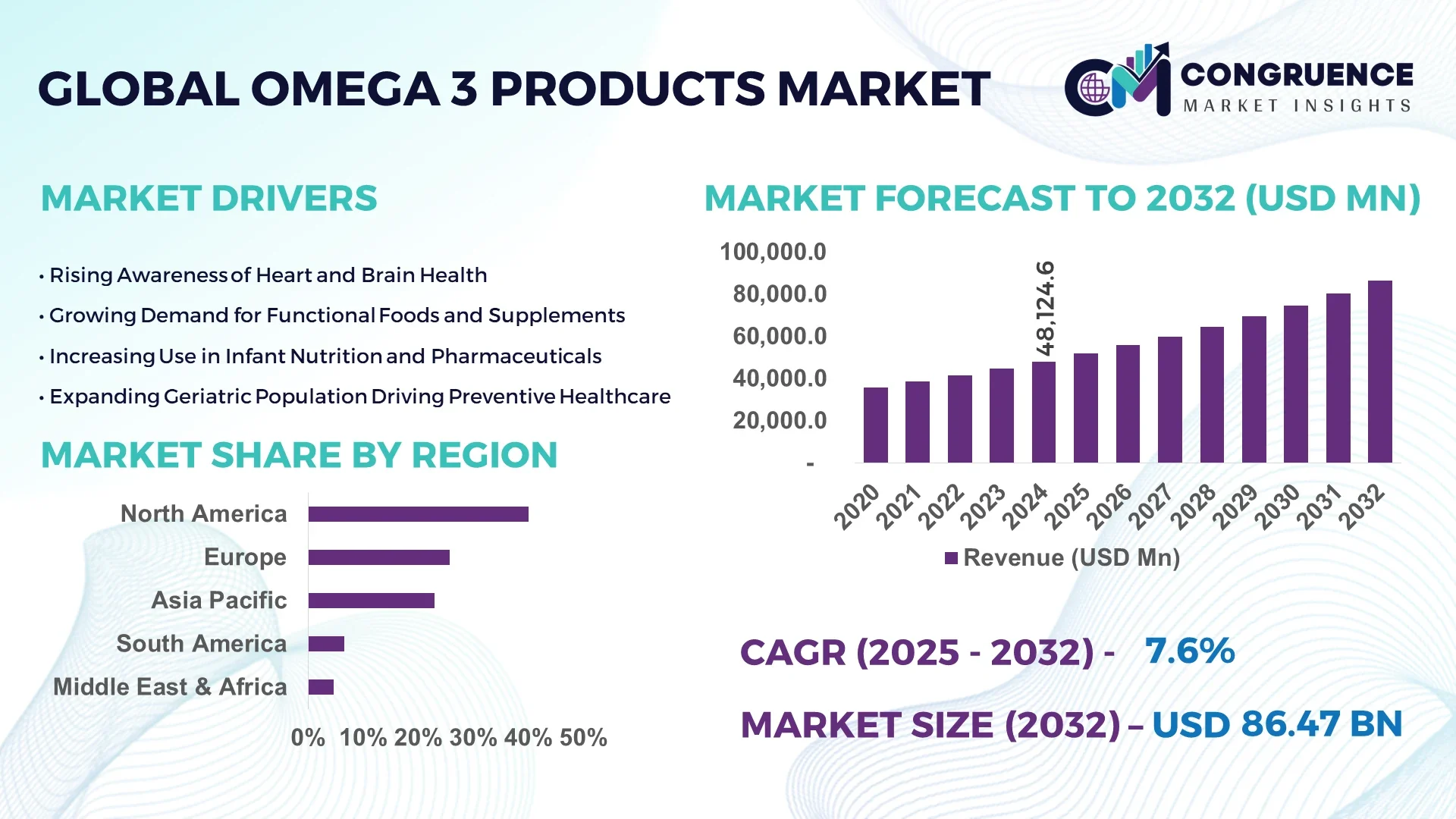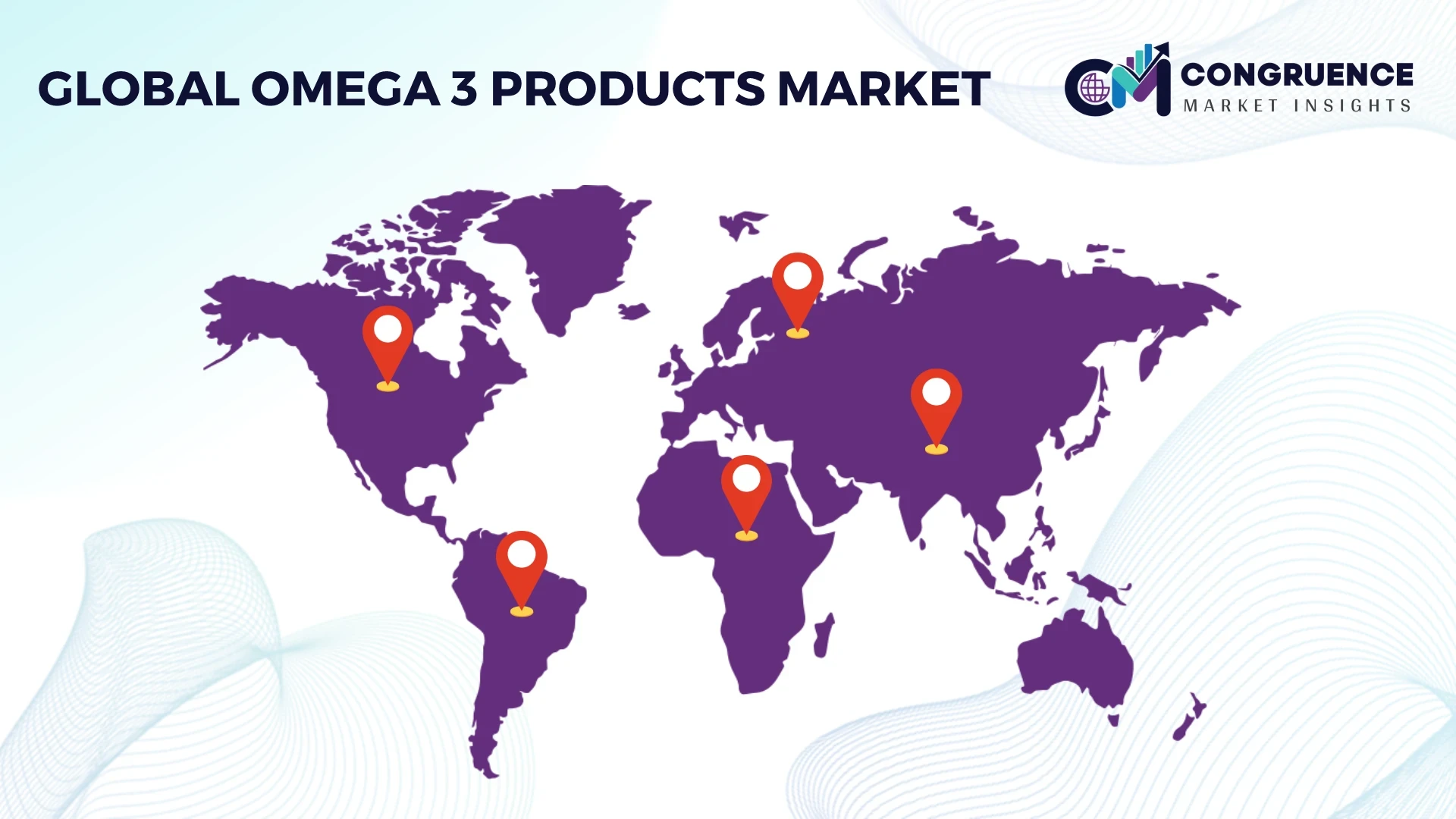Reports
The Global Omega 3 Products Market was valued at USD 48,124.6 Million in 2024 and is anticipated to reach a value of USD 86,470.0 Million by 2032, expanding at a CAGR of 7.6% between 2025 and 2032.

Omega 3 fatty acids, including EPA, DHA, and ALA, are essential nutrients known for their benefits in cardiovascular health, cognitive function, and inflammatory response. The market's growth is driven by increasing consumer awareness of these health benefits, leading to higher demand for omega 3-enriched products. The expansion of applications across pharmaceuticals, dietary supplements, and functional foods further propels market growth. Additionally, the development of sustainable and plant-based omega 3 sources caters to the growing vegan and vegetarian populations, contributing to the market's diversification and expansion.
Artificial Intelligence (AI) is revolutionizing the Omega 3 Products Market by enhancing production efficiency, quality control, and supply chain management. AI algorithms analyze vast datasets to optimize extraction processes, ensuring higher purity and yield of omega 3 fatty acids. In quality control, machine learning models detect anomalies in product batches, maintaining consistent product standards. AI-driven predictive analytics forecast demand trends, enabling manufacturers to adjust production schedules proactively, reducing waste and meeting market needs effectively. Furthermore, AI facilitates personalized nutrition by analyzing individual health data to recommend specific omega 3 formulations, aligning with the trend towards customized health solutions. The integration of AI in marketing strategies also allows for targeted advertising, reaching consumers more effectively and increasing product visibility.
In March 2024, DSM-Firmenich partnered with SCN BestCo to develop high-load Omega-3 gummies incorporating Life’s OMEGA O33-P100, utilizing AI-driven formulation techniques to enhance bioavailability and consumer appeal.
The Omega 3 Products Market is experiencing growth due to rising consumer awareness of the health benefits associated with omega 3 fatty acids. Studies indicate that omega 3s play a crucial role in heart health, brain function, and reducing inflammation. This awareness has led to increased consumption of omega 3 supplements and fortified foods. The demand is particularly notable in regions with aging populations, where omega 3s are sought for their potential in managing age-related health issues. The market responds with a diverse range of products, including capsules, gummies, and enriched foods, to meet varying consumer preferences.
A significant restraint in the Omega 3 Products Market is the fluctuation in raw material availability, particularly from marine sources like fish oil. Overfishing and environmental concerns have led to inconsistent supply and increased prices of fish-derived omega 3s. Additionally, climatic changes affect the population of omega 3-rich fish species, further impacting supply stability. These factors pose challenges for manufacturers in maintaining consistent product availability and pricing, potentially hindering market growth.
The growing demand for plant-based diets presents an opportunity for the Omega 3 Products Market to expand its offerings. Algae-based omega 3s, for instance, provide a sustainable and vegan-friendly alternative to fish oil. Technological advancements have improved the extraction and purification processes of plant-based omega 3s, enhancing their efficacy and appeal. This expansion caters to a broader consumer base, including vegetarians, vegans, and those with fish allergies, thereby opening new market segments and driving growth.
Navigating the complex regulatory landscape across different regions poses a challenge for the Omega 3 Products Market. Variations in health claims, labeling requirements, and approval processes can delay product launches and increase compliance costs. For example, what is permissible in one country regarding omega 3 health benefits may not be allowed in another, requiring tailored marketing strategies. These regulatory hurdles necessitate thorough understanding and strategic planning by companies to ensure successful market entry and sustained operations globally.
The Omega 3 Products Market is experiencing significant growth, driven by increasing consumer awareness of the health benefits associated with omega-3 fatty acids, particularly EPA and DHA. In 2023, fish oil dominated the market, accounting for a revenue of USD 4,380.4 million. Krill oil is emerging as a lucrative segment, registering the fastest growth due to its higher bioavailability and sustainable sourcing.
Soft gel capsules are the preferred form of omega-3 supplements, holding a 48% market share in 2023, attributed to their convenience and ease of swallowing. Liquid forms are gaining popularity, especially among children and older adults, with an annual adoption rate increase of 6.8%.
The market is also witnessing a shift towards plant-based omega-3 sources, such as algae oil, driven by the growing vegan population and environmental concerns. Algae-based omega-3 supplements are growing rapidly, with an annual growth rate of 10.2%.
Regionally, North America accounted for 37.1% of the global omega-3 supplements market revenue in 2023, with the U.S. leading in terms of revenue. Canada is expected to register the highest CAGR from 2024 to 2030.
The Omega 3 Products Market is segmented by type, application, and end-user, each contributing uniquely to the market dynamics.
EPA is renowned for its anti-inflammatory properties, playing a crucial role in cardiovascular health. Its demand is increasing due to its benefits in reducing high blood pressure and triglyceride levels. The European Food Safety Authority recommends daily EPA intake for pregnant women to support fetal brain and nervous system development.
DHA is essential for brain development and function, making it a critical component in infant formulas and prenatal supplements. In 2023, DHA dominated the market with a revenue share of more than 56%, attributed to its growing utilization in infant formulas and geriatric nutrition products.
ALA, a plant-based omega-3 fatty acid, is gaining popularity among vegetarians and vegans. Its inclusion in the market caters to the growing demand for plant-based and sustainable omega-3 sources. The plant source segment is expected to register growth over the forecast period, mainly because of the global demand for vegetable oils obtained from seeds of soybeans, safflower, sunflower, cotton, and corn.
Omega-3 fatty acids are increasingly used in pharmaceuticals for their benefits in treating cardiovascular diseases, depression, and inflammatory conditions. The pharmaceuticals segment is expected to register significant growth over the forecast period, driven by its growing usage in the dermatology sector due to its scalp nourishment properties.
Dietary supplements remain the largest application segment, driven by the general population's increasing health consciousness. Approximately 40% of omega-3 supplement consumers purchase these products for cardiovascular health, making it the most common use case.
The incorporation of omega-3 in functional foods and beverages is on the rise, catering to consumers seeking health benefits through their regular diet. Supplements & functional foods dominated the market with a revenue share of over 51% in 2023.
DHA's role in brain and visual development makes it a vital ingredient in infant nutrition. The demand for omega-3 in infant formulas is increasing, especially in countries like India, China, Japan, Australia, and Thailand.
Omega-3 is incorporated into animal feed and pet food to promote health benefits such as improved coat condition and joint health. The shift among pet owners to take extra care in choosing pet products positively affected omega-3-based pet foods.
Adults constitute a significant portion of omega-3 consumers, primarily for cardiovascular and cognitive health benefits. Approximately 40% of omega-3 supplement consumers purchase these products for cardiovascular health.
The elderly population uses omega-3 supplements to manage age-related health issues such as arthritis, cognitive decline, and cardiovascular diseases. The growing aging population is expected to fuel the demand for omega-3-based pharmaceutical products.
Infants require DHA for brain and visual development, making omega-3 a critical component in infant nutrition. The demand for omega-3 in infant formulas is increasing, especially in countries like India, China, Japan, Australia, and Thailand.
Pregnant women are advised to consume omega-3, particularly DHA, to support fetal development. The European Food Safety Authority recommends daily EPA intake for pregnant women to support fetal brain and nervous system development.
North America accounted for the largest market share at 37.4% in 2024; however, Asia Pacific is expected to register the fastest growth, expanding at a CAGR of 9.1% between 2025 and 2032.

North America’s dominance is attributed to strong consumer awareness, high penetration of nutraceuticals, and the widespread consumption of dietary supplements in the U.S. and Canada. Europe followed closely due to the presence of established healthcare systems and regulatory support for functional foods. Meanwhile, rapid urbanization, increased disposable incomes, and shifting dietary preferences in Asia Pacific are propelling omega-3 product demand across countries such as China, India, and Japan. South America and the Middle East & Africa also demonstrate positive outlooks due to rising health awareness and expanding retail availability of omega-3 fortified products.
Strong Supplement Adoption and Premium Product Demand Drive Growth
North America remains the leading consumer of omega-3 products, driven by robust demand for high-end nutraceuticals and supplements. In 2024, the region held over 37.4% of the global market share. The U.S. leads with its mature dietary supplement sector, where over 70% of adults report regular use of health-enhancing products. Fish oil capsules and fortified foods are popular, especially for cardiovascular and cognitive health. Innovations in encapsulation technology and flavor masking have further boosted consumption. Major players are investing in R&D to introduce organic and sustainably sourced omega-3 supplements, meeting growing consumer demand for clean-label products.
Sustainable Omega-3 Sources Gain Popularity Across European Nations
Europe’s omega-3 market is marked by a rising preference for plant-based and sustainable alternatives like algal oil. Countries such as Germany, France, and the UK are emphasizing eco-conscious sourcing and regulatory compliance, which influences consumer purchasing decisions. In 2024, Europe accounted for approximately 28.6% of the global omega-3 products market. The region’s strong pharmaceutical and food industries integrate omega-3 into a range of applications, from prenatal supplements to functional dairy products. EU-backed public health campaigns are also promoting omega-3 intake for heart and brain health, creating consistent demand across multiple end-user categories.
Rising Health Consciousness and Urbanization Fuel Growth in Asia-Pacific
Asia-Pacific is witnessing the fastest growth in the omega-3 products market, supported by rising middle-class income, urban dietary transitions, and increasing healthcare spending. In 2024, the region accounted for 21.8% of the global market, with China, India, Japan, and South Korea leading demand. Consumer awareness of omega-3’s benefits for vision, heart, and brain health is growing, especially among aging populations. The inclusion of omega-3 in infant formulas and functional beverages is also expanding rapidly. Local manufacturers are introducing affordable products tailored to regional preferences, while multinational brands are strengthening their distribution networks across APAC countries.
Expanding Retail Access and Education Initiatives Drive Market Entry
The Middle East & Africa omega-3 products market is gradually expanding due to improved access to dietary supplements and growing health education. In 2024, the region accounted for 7.2% of the global market. Countries like the UAE, Saudi Arabia, and South Africa are experiencing a surge in demand for omega-3 enriched products as non-communicable diseases such as cardiovascular disorders and diabetes rise. Government-led awareness campaigns and the growing presence of international health brands in urban centers are enhancing product visibility. Retail pharmacies, supermarkets, and online platforms have made omega-3 supplements more accessible to the general population, supporting long-term market potential.
The global Omega-3 products market is characterized by intense competition, with numerous key players striving to enhance their market presence through strategic initiatives. Companies are investing heavily in research and development to innovate and introduce advanced products that cater to the evolving consumer demands for health and wellness. For instance, in March 2023, Epax invested approximately USD 40 million in molecular distillation technology to improve the processing of highly concentrated omega-3, aiming to enhance product quality and meet the increasing demand for purified omega-3 supplements . Additionally, the market is witnessing a surge in partnerships and collaborations aimed at expanding product portfolios and geographical reach. The entry of new players, coupled with the expansion strategies of existing ones, is intensifying the competition, prompting companies to focus on product differentiation, quality enhancement, and customer engagement to maintain a competitive edge. The emphasis on sustainable sourcing and eco-friendly production processes is also becoming a significant factor influencing competitive dynamics in the Omega-3 products market.
Companies Profiled in the Omega-3 Products Market Report
· Aker Biomarine Antarctic AS
· Orkla Health
· BASF SE
· Omega Protein Corp.
· GC Rieber Oils
· Lonza
· Croda International Plc
· EPAX
· BioProcess Algae, LLC
Technological advancements are playing a pivotal role in shaping the Omega-3 products market, driving innovation and enhancing product efficacy. Companies are focusing on developing advanced extraction and purification techniques to improve the quality and concentration of Omega-3 fatty acids. For example, the adoption of molecular distillation technology allows for the production of highly concentrated Omega-3 oils, meeting the growing consumer demand for potent supplements . Moreover, the integration of microencapsulation technology has enabled the encapsulation of Omega-3 oils within microscopic particles, protecting them from degradation and improving taste, thereby enhancing consumer compliance . The development of plant-based Omega-3 sources, such as algal oil, is also gaining traction, offering sustainable and vegetarian alternatives to traditional fish oil. These technological innovations are not only improving product quality and shelf-life but also expanding the application scope of Omega-3 fatty acids across various industries, including pharmaceuticals, nutraceuticals, and functional foods. As consumer awareness about the health benefits of Omega-3 continues to rise, technological advancements will remain a key driver in meeting the evolving market demands.
In February 2023, GC Rieber VivoMega introduced VivoMega Algae Oils, a line of high-concentration vegan Omega-3 sourced from microalgae, catering to the growing demand for plant-based supplements.
In March 2023, Pelagia invested USD 40 million in the facility of Epax, a subsidiary of Pelagia, in Aalesund. This facility will help the company implement new technology known as EOP+Tech for EPA & DHA products.
In May 2023, Nuseed Global introduced Nuseed Nutriterra plant-based oil enriched with Omega-3, tailored to meet the needs of the human nutrition and dietary supplement markets.
In September 2023, Aker BioMarine and Swisse introduced Swisse Ultiboost High Strength Krill Oil, incorporating Aker BioMarine's Superba Boost Krill oil, which received approval and is now listed on the Australia Register of Therapeutic Goods (ARTG) under AUST L(A) 417392.
In October 2023, dsm-firmenich announced the upcoming North American launch of life’s®OMEGA O3020, the first and only single-source algal Omega-3 with the same EPA to DHA ratio naturally found in standard fish oil, but with twice the potency.
The Omega-3 Products Market Report offers a comprehensive analysis of the global market, encompassing various aspects such as market size, growth trends, competitive landscape, and segmental overview. The report delves into the different types of Omega-3 products, including EPA, DHA, and ALA, and their applications across dietary supplements, pharmaceuticals, infant formulas, food & beverages, and pet food. It also examines the end-user segments, highlighting the preferences and consumption patterns across different demographics. Geographically, the report covers key regions, including North America, Europe, Asia-Pacific, South America, and the Middle East & Africa, providing insights into regional market dynamics and growth opportunities. Furthermore, the report profiles major global market players, analyzing their strategies, product portfolios, and market positioning. By offering detailed information on market drivers, restraints, opportunities, and challenges, the report serves as a valuable resource for stakeholders seeking to make informed decisions and capitalize on emerging trends in the Omega-3 products market.
| Report Attribute/Metric | Report Details |
|---|---|
|
Market Revenue in 2024 |
USD 48,124.6 Million |
|
Market Revenue in 2032 |
USD 86,470.0 Million |
|
CAGR (2025 - 2032) |
7.6% |
|
Base Year |
2024 |
|
Forecast Period |
2025 - 2032 |
|
Historic Period |
2020 - 2024 |
|
Segments Covered |
By Types
By Application
By End-User
|
|
Key Report Deliverable |
Revenue Forecast, Growth Trends, Market Dynamics, Segmental Overview, Regional and Country-wise Analysis, Competition Landscape |
|
Region Covered |
North America, Europe, Asia-Pacific, South America, Middle East, Africa |
|
Key Players Analyzed |
Aker Biomarine Antarctic AS, Orkla Health, BASF SE, Omega Protein Corp., GC Rieber Oils, Lonza, Croda International Plc, EPAX, BioProcess Algae, LLC, Koninklijke DSM N.V. |
|
Customization & Pricing |
Available on Request (10% Customization is Free) |
